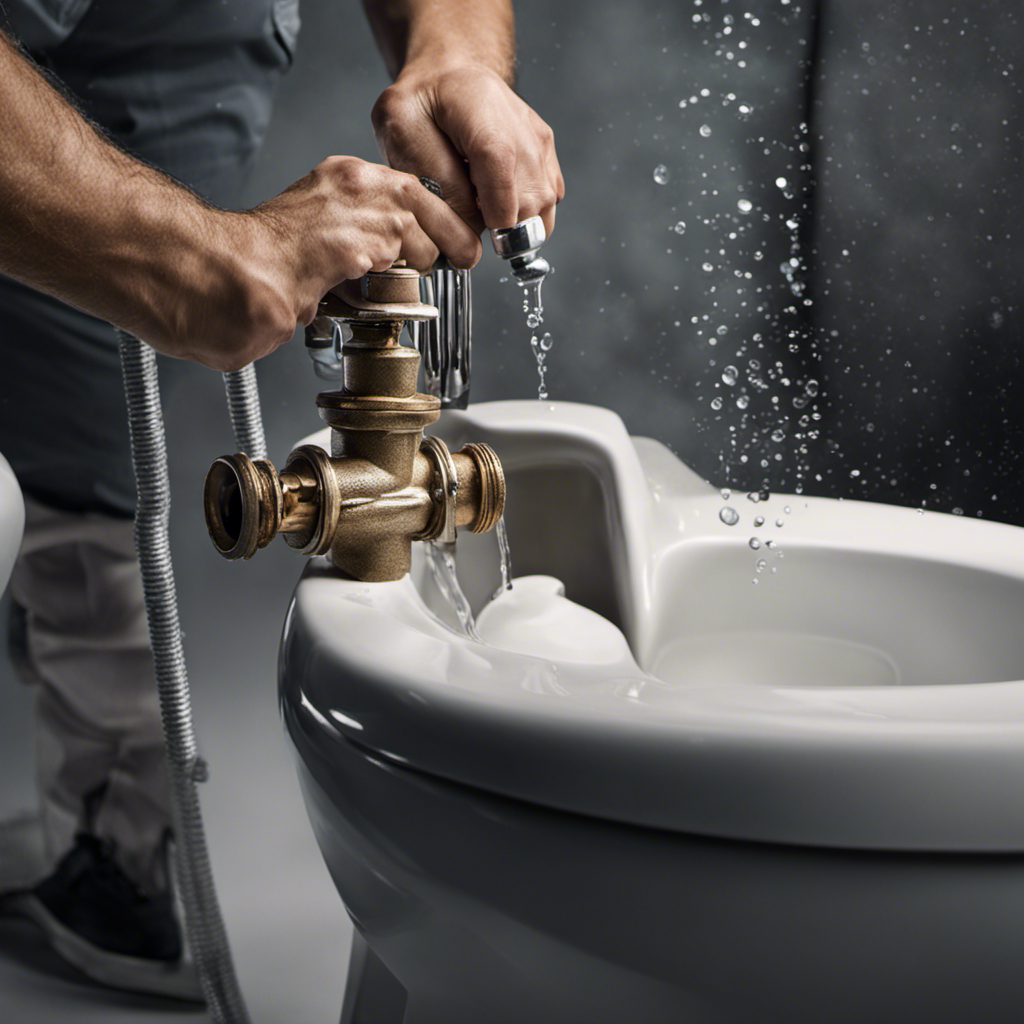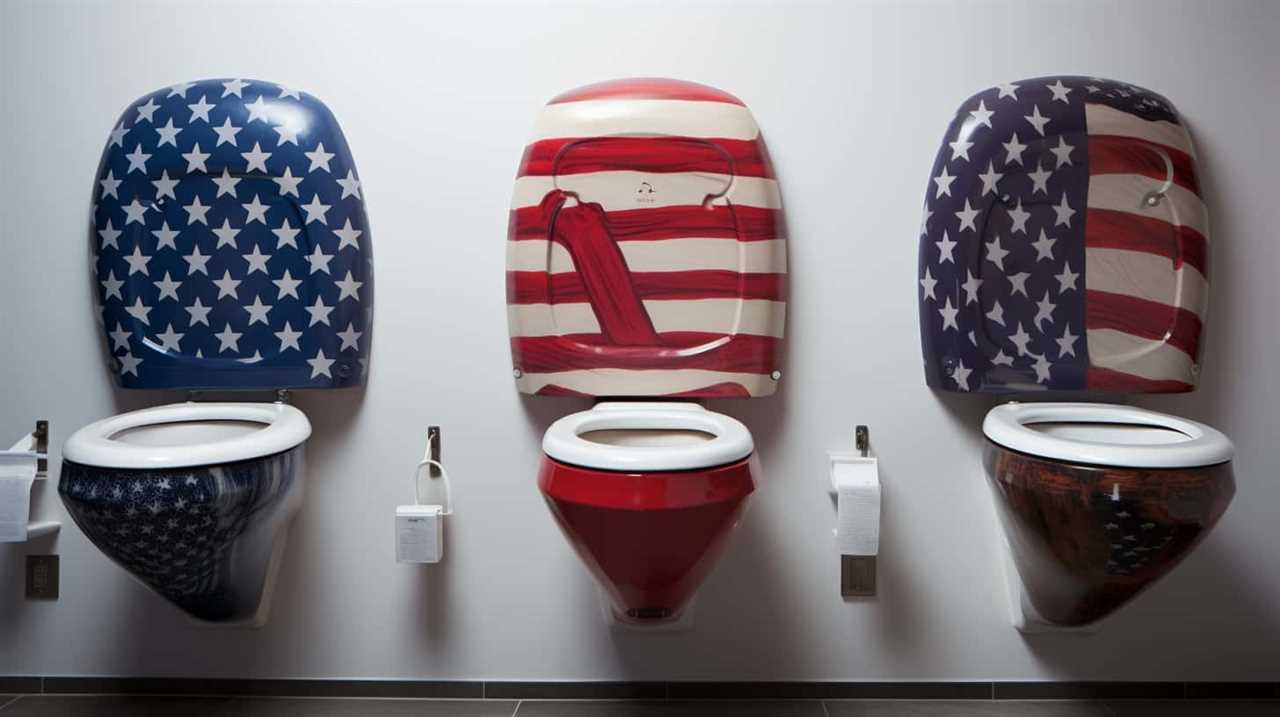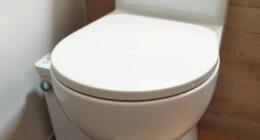Have you ever had that frustrating moment when your toilet just won’t stop running? It’s like a never-ending stream of wasted water, draining your patience along with your wallet.
But fear not, because I’m here to help you tackle this common household issue. In this article, I’ll guide you through the steps to troubleshoot and fix your running toilet.
So, grab your wrench and get ready to become a DIY plumbing expert!
Key Takeaways
- Turn off the water valve before inspecting the water supply line.
- Check for obstructions or blockages that may affect water flow and clear any debris or sediment.
- Identify the issue with the fill valve and clean the valve components with a soft brush and vinegar solution.
- Adjust the float level and chain to stop the water from running and ensure proper operation.
Checking the Water Supply Line
Before checking the water supply line, make sure to turn off the water valve. This step is crucial to prevent any water leakage or accidents.
When troubleshooting water flow issues in a running toilet, it is essential to inspect the water supply line. Start by examining the line for any visible damages such as cracks or leaks. If you notice any, it may be necessary to replace the water supply line.
Additionally, check for any obstructions or blockages that could be affecting the water flow. Clearing any debris or sediment can often solve the problem.
Remember to be cautious and methodical when handling the water supply line to avoid further damage or complications.
Adjusting the Float Level
To fix a constantly running toilet, you may need to adjust the float level. The float mechanism controls the water level in the tank, and if it is set too high, the toilet will continuously run.
Here are some steps to adjust the float level and troubleshoot common toilet problems:
-
Lift the lid of the toilet tank and locate the float. It is usually a ball or a cylinder attached to an arm.
-
Look for an adjustment screw or a clip on the float mechanism. This allows you to change the float level.
-
Gradually adjust the float level by turning the screw or moving the clip up or down. The goal is to set it at a level that stops the water from running.
-
Flush the toilet and observe if the problem is fixed. If not, repeat the adjustment process until the running stops.
Inspecting the Flapper Valve
When it comes to toilet maintenance, it’s important to address issues with the flapper valve. Flapper leaks can occur due to various reasons such as wear and tear, mineral deposits, or a misaligned flapper.
If a replacement is needed, it’s essential to choose a flapper valve that is compatible with your toilet model.
Additionally, adjusting the flapper chain can help ensure a proper seal and prevent any leaks from occurring in the future.
Causes of Flapper Leaks
One common cause of flapper leaks is if you’ve recently replaced the flapper and it’s not installed properly. Installing the flapper correctly is crucial to ensure a proper seal and prevent leaks.
Here are some common flapper problems and troubleshooting steps to address them:
-
Misalignment: Check if the flapper is properly aligned with the flush valve seat. If it’s not, adjust it to ensure a tight seal.
-
Damage or Wear: Inspect the flapper for any signs of damage or wear, such as cracks or warping. If found, replace the flapper with a new one.
-
Chain Length: Ensure the chain connecting the flapper to the flush handle is the correct length. If it’s too long or too short, it can prevent the flapper from sealing properly.
-
Debris Buildup: Clean any debris or mineral deposits that may be preventing the flapper from closing tightly. Use vinegar or a mild cleaner to remove any buildup.
Replacing the Flapper Valve
Installing the flapper correctly is crucial to ensure a proper seal and prevent leaks. When it comes to flapper valve maintenance, it’s important to know how to replace the flapper valve when necessary.
If you’re experiencing issues with your flapper valve, troubleshooting can help identify the problem. Start by checking if the flapper is properly aligned and centered over the flush valve opening. Ensure that the chain connecting the flapper to the flush lever is not too tight or too loose.
If the flapper is worn out or damaged, it’s time to replace it. Turn off the water supply, remove the old flapper, and install the new one, making sure it fits securely over the flush valve.
Adjusting the Flapper Chain
Make sure you check the length of the flapper chain and adjust it as needed. This is an important step in troubleshooting a running toilet.
Here are some steps to help you adjust the flapper chain properly:
-
Locate the flapper chain: It is connected to the flush handle and the flapper valve.
-
Check the length: The chain should have a little bit of slack, but not too much. It should be long enough to allow the flapper to close completely.
-
Adjust the length: If the chain is too long, shorten it by removing a link. If it is too short, add a link or two.
-
Test and observe: Flush the toilet and watch the flapper. It should open fully when you flush and close tightly when the water stops running.
Adjusting the flapper chain can help ensure proper functioning of the flapper valve and prevent a running toilet. If the problem persists, you may need to consider flapper replacement as the next troubleshooting step.
Cleaning or Replacing the Fill Valve
When it comes to repairing a faulty valve in your plumbing system, it’s important to approach the task with knowledge and precision.
First, identify the issue with the valve, whether it’s a leak, a blockage, or a malfunctioning component.
Next, gather the necessary tools and materials to fix the problem, such as replacement parts or cleaning agents.
If the valve is beyond repair or outdated, upgrading to newer technology may be a practical solution to ensure the long-term functionality of your plumbing system.
Repairing a Faulty Valve
To fix a faulty valve, you’ll need to check for any leaks or damage. Here are the steps to repairing a broken valve and troubleshooting water flow issues:
-
Turn off the water supply: Locate the shut-off valve near the toilet and turn it clockwise to stop the water flow.
-
Remove the valve cap: Unscrew the cap on top of the valve using a wrench or pliers. This will expose the valve mechanism.
-
Inspect for leaks or damage: Look for any signs of water leakage or cracks in the valve body. If found, you may need to replace the entire valve.
-
Clean or replace the valve components: If there are no leaks or visible damage, clean the valve parts with a soft brush and vinegar solution. Alternatively, replace the faulty components with new ones.
Upgrading to Newer Technology
After considering repairing the faulty valve, another option to tackle a running toilet is upgrading to newer technology. Upgrading your toilet can offer several benefits, including improved water efficiency, enhanced performance, and increased durability. By investing in a newer model, you can save on water bills and reduce your environmental impact. However, it’s important to consider the cost of upgrading. Newer toilets can range in price depending on the features and brand, so it’s essential to research and compare options before making a decision. While the upfront cost may be higher, the long-term savings and benefits make upgrading a worthwhile investment. Below is a table comparing the benefits and costs of upgrading a toilet:
| Benefits | Cost |
|---|---|
| Improved water efficiency | Varies by model |
| Enhanced performance | Varies by model |
| Increased durability | Varies by model |
Fixing the Flush Handle or Chain
You can fix the flush handle or chain by adjusting their position or tightening any loose connections. Here’s what you can do:
-
Replacing the handle: If the handle is broken or not functioning properly, it may need to be replaced. Simply unscrew the old handle and attach a new one, ensuring it is securely fixed.
-
Troubleshooting the chain: If the chain is too loose or too tight, it can cause issues with the flushing mechanism. Adjust the length of the chain by either lengthening or shortening it, making sure there is enough slack for proper operation.
-
Checking for obstructions: Sometimes, debris or objects may get stuck in the chain or handle mechanism, preventing it from functioning correctly. Clear any obstructions to restore proper functionality.
-
Inspecting for rust or corrosion: Over time, the handle or chain may become rusty or corroded, affecting its performance. If you notice any signs of rust or corrosion, consider replacing the affected parts.
Seeking Professional Help if Needed
If the issue persists or becomes more complicated, it’s best to consult with a professional for assistance. While it’s possible to troubleshoot and fix some toilet issues on your own, there are instances when seeking professional advice is necessary.
If you’ve tried DIY troubleshooting methods and the toilet still keeps running, it could indicate a more serious underlying problem. A professional plumber has the expertise and tools to accurately diagnose and repair the issue. They can identify the root cause of the problem, whether it’s a faulty valve, worn-out components, or a more complex plumbing issue.
Conclusion
In conclusion, dealing with a running toilet can be a frustrating experience. However, it is a problem that can often be fixed with a few simple steps.
First, you should check the water supply line and make sure it is properly connected. Next, adjusting the float level may help stop the toilet from running continuously. You should also inspect the flapper valve to see if it is worn out or damaged. Cleaning or replacing the fill valve can also help resolve the issue.
If the problem persists or seems too complicated, it’s always a good idea to seek professional help. Remember, with a little investigation and some basic knowledge, you can easily fix a running toilet and restore peace to your bathroom.










